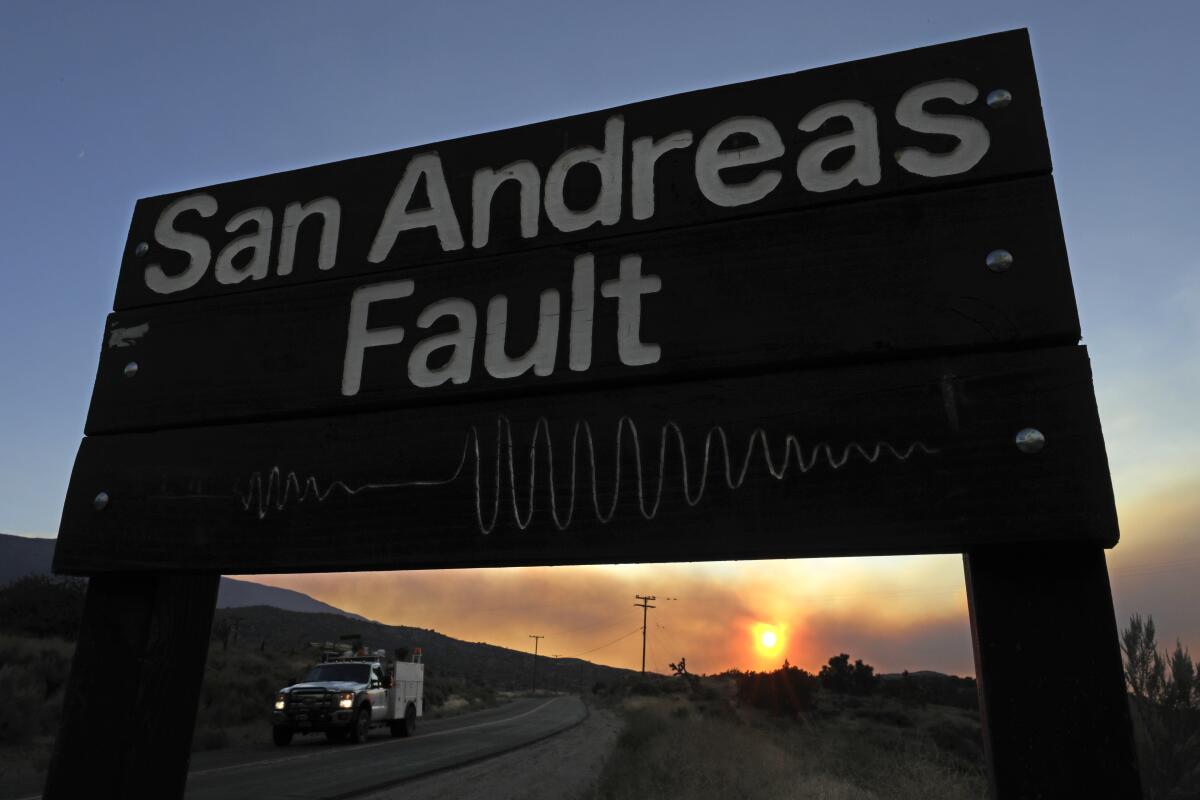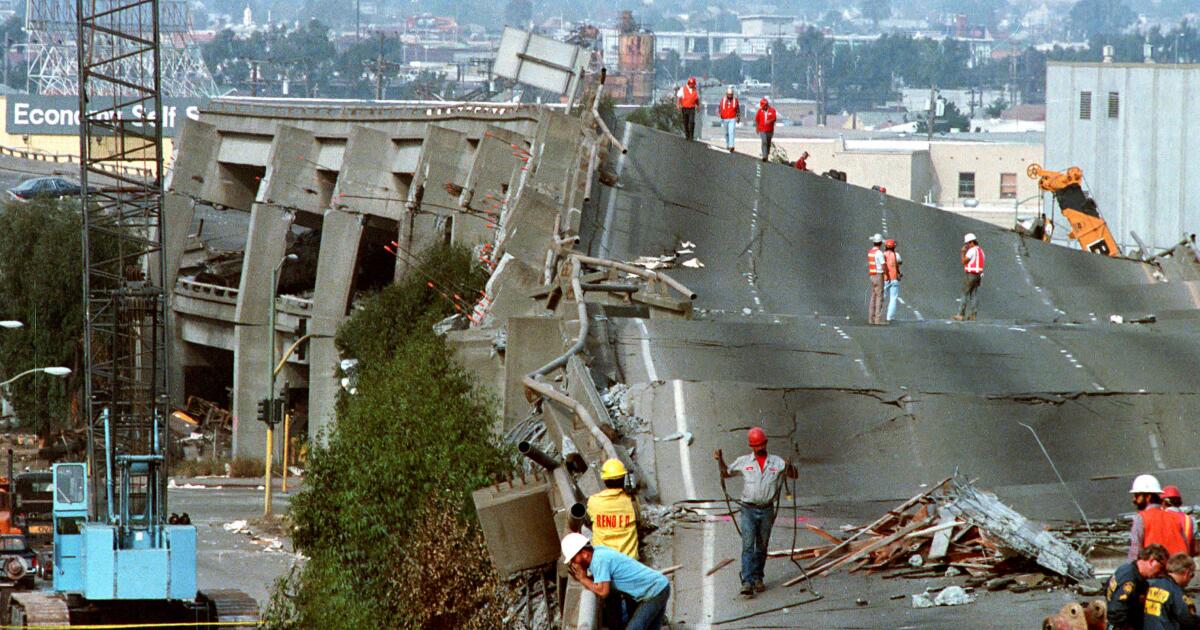They are two of the West Coast’s most destructive generators of huge earthquakes: the San Andreas fault in California and the Cascadia subduction zone offshore of California’s North Coast, Oregon, Washington and British Columbia.
The public has often thought of these danger zones as separate entities.
But what if they were capable of back-to-back disasters?
That’s the unsettling possibility described in a groundbreaking new study published recently in the journal Geosphere.
The authors suggest that, for thousands of years, large earthquakes on the Cascadia subduction zone were quickly followed by large earthquakes on the northern San Andreas fault.
In 1700, a Cascadia subduction zone earthquake is believed to have measured around a magnitude 9. Based on archaeological evidence, villages sank and had to be abandoned, according to the U.S. Geological Survey. That earthquake was so powerful, entire sections of the Pacific coastline dropped by as much as 5 feet. In the Pacific Northwest, Native American stories told of “how the prairie became ocean” and canoes were flung into trees.
The study suggests the Cascadia earthquake was followed by a northern San Andreas fault earthquake from Cape Mendocino toward San Francisco, with a magnitude of around 7.9.
The San Andreas fault along the Elkhorn Scarp pressure ridge is shown.
(David McNew / Getty Images)
“What that suggests is that the San Andreas earthquake happened very closely in time after the Cascadia earthquake,” said Jason R. Patton, engineering geologist with the California Geological Survey and a co-author of the study.
The evidence suggests the San Andreas fault in 1700 ruptured in an earthquake within hours to days of the Cascadia earthquake. “It could have even been minutes, but we can’t nail it down,” said the study’s lead author, Chris Goldfinger, a paleoseismologist with Oregon State University and a professor emeritus of marine geology.
The hypothesized one-two punch of earthquakes was probably “not just a black swan chance-in-a-million,” Goldfinger said. “This is, like, most of the time. The only exception in the last 2,500 years was 1906 — that was the only event” in which a major quake on the northern San Andreas fault wasn’t preceded by a huge quake on the Cascadia subduction zone, according to the analysis of available data.
A huge Cascadia earthquake followed by a northern San Andreas fault earthquake likely also happened sometime between 1425 and 1475; between 1175 and 1225; and around the years AD 825 and 475 BC, according to Goldfinger.

The Cascadia subduction zone, capable of producing a magnitude 9 earthquake, is offshore of California’s North Coast, Oregon, Washington and British Columbia.
(John Wesley Powell Center for Analysis and Synthesis / USGS)
The implications of the authors’ conclusion are significant. Emergency managers have long feared a repeat of either the 1906 San Francisco earthquake or the 1700 Cascadia earthquake and tsunami.
A repeat of the 1906 earthquake could result in thousands of deaths, and hundreds of billions of dollars in property losses, according to one estimate.
A magnitude 9 earthquake on the Cascadia subduction zone could create tsunami wave heights that would wash away coastal towns, destroy U.S. 101 and cause $70 billion in damage over a large swath of the Pacific Coast. More than 100 bridges would be lost, power lines toppled and coastal towns isolated. Residents would have as little as 15 minutes’ notice to flee to higher ground, and as many as 10,000 would perish, according to a scenario published more than a decade ago. Seaports could suffer major damage.

The San Andreas fault runs through Juniper Hills.
(Myung J. Chun / Los Angeles Times)
To be sure, the findings from the study are hypotheses. Scientists won’t know for sure if big Cascadia earthquakes trigger large northern San Andreas fault earthquakes unless it happens in the future, Patton said.
But the study’s implications suggest that a big earthquake on the Cascadia subduction zone could result in the northern San Andreas fault rupturing in a big earthquake minutes to hours later, or possibly months or years later, Goldfinger said.
Just “one of these big events will draw down the resources of the whole country trying to respond to it,” Goldfinger said. “So if you have two of those, you double up on that.”
The other key implication is the inference that most past earthquakes on the northern San Andreas fault may have started around Cape Mendocino and then headed toward San Francisco. Such a scenario would bring worse shaking to San Francisco than what occurred in 1906, when the epicenter was around the Golden Gate strait but then moved away from the city.
The key to the study was investigating pieces of earth plucked by scientists from a ship collecting samples from deep beneath the seafloor. Earthquakes trigger submarine landslides, and leave deposits called “turbidites” that are buried over time.
Normally, scientists would expect an earthquake to result in a familiar pattern — coarse sand at the bottom, indicating massive landslides resulting from a huge quake, and finer, silty sediment on the top, as lighter material settles down, Goldfinger said.
But scientists were stuck with a mystery for decades.
In only one particular area just off the California coast — around Noyo Canyon, very close to the San Andreas fault, but about 50 miles away from the Cascadia subduction zone — seafloor samples seemed upside down, with finer silty deposits on the bottom, and coarser sand grains on top. Scientists had no way to explain it, a mystery that was “super annoying,” Goldfinger said.
It would take more than 15 years before the potential answer dawned on them.
Under this explanation, the finer, silty deposits were deposited first from a farther-away quake on the Cascadia subduction zone. The Cascadia quake was about 50 miles away from Noyo Canyon, and so with that distance, the level of ground shaking was weaker, “and … the first thing it’s going to lay down is finer grain sediments,” Goldfinger said.
That was then quickly followed by a triggered earthquake on the much-closer San Andreas fault, which brought stronger shaking and caused the tumbling of coarser sand grains on top of the silty layer laid by the quake, according to Goldfinger.
When researchers came up with this potential explanation, “suddenly, it all made sense,” Goldfinger said.
Scientists have found more evidence in recent years to confirm the existence of a northern San Andreas fault earthquake in 1700 — right around the time of the Cascadia earthquake.
For one, there is evidence of a massive earthquake on the northern San Andreas fault from around Cape Mendocino through to San Francisco in 1700, including clues found in Lake Merced near the San Francisco Zoo, Goldfinger said, as well as in other sites north of the city.
Coincidentally, another group of scientists using a completely different methodology — ring patterns and other observations of old coast redwood trees — published a recent study suggesting the last major earthquake on the northern San Andreas before 1906 was roughly around 1700.
That was “pretty good corroboration of what we’re proposing,” Goldfinger said.
That earthquakes can trigger other earthquakes has been demonstrated before. Scientists believe that the magnitude 6.1 Joshua Tree temblor of April 22, 1992, resulted in aftershocks that kept migrating north. They eventually triggered on June 28 the magnitude 7.3 Landers earthquake in the Mojave Desert — strong enough to cause shaking in Denver — and, hours later, a magnitude 6.3 earthquake in Big Bear.
Anytime a big earthquake occurs, the Earth’s crust around the ruptured fault gets squeezed and stretched, Patton said. In some places, that seismic strain is alleviated; in others, it worsens — making earthquake faults in that area even closer to potentially failing and resulting in another big earthquake.
Goldfinger and Patton were among the co-authors of a research article published in 2008 in the Bulletin of the Seismological Society of America that found that a big earthquake on the Cascadia subduction zone slightly worsens the seismic stress on the northernmost section of the San Andreas fault.
This story originally appeared on LA Times

